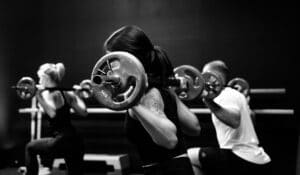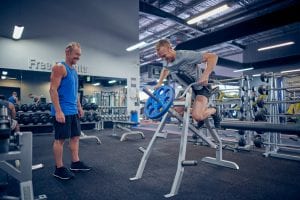Pumped any iron lately? If not, you may want to consider it. Resistance exercise is a great way to round out an aerobic workout and help you stay strong. I’ll discuss the ins and outs of resistance exercise in this article and then suggest two basic training plans to get you started.
New benefits of resistance exercise seem to be discovered all the time. Research to date shows that resistance exercise is associated with improvements in all of the following:
Muscular strength and endurance
Functional capacity and ability (falling, climbing stairs)
Blood pressure
Osteoporosis
Sarcopenia (loss of muscle as we age)
Low back pain
Insulin resistance and glucose metabolism
Resting metabolic rate
Body fat
Psychological well-being
Is it ever too late?
It’s never too late to start a resistance-exercise program. In a classic study in a Boston nursing home, 100 residents ranging from 72-98 years of age performed resistance exercise three times a week for 10 weeks. Muscle strength increased 113%, walking speed increased by almost 12%, and thigh-muscle area increased 2.7%
What is resistance exercise?
Resistance exercise is any exercise where muscles contract against an external resistance with the objective of increasing strength, tone, mass, and/or muscular endurance. The resistance can come from dumbbells, weight machines, elastic tubing or bands, cinder blocks, cans of soup, your own body weight (for example, pushups), or any other object that forces your muscles to contract. Results take time but are sure to come when you train consistently over time.
What are types of resistance exercises?
There are several types or styles of resistance exercise. Power lifting (a weight-lifting competition in which participants compete in the squat, dead lift, and bench press), Olympic weight lifting (the type you see on TV where athletes lift the weight overhead), strength training (lifting weights to get stronger), and weight lifting (the sport of lifting heavy weight, typically fewer than six repetitions).
What is progressive overload?
One of the fundamentals of resistance exercise is the principle of progressive overload. Progressive overload, as the term suggests, means that you increase the workload gradually over time as your muscles accommodate to the resistance, with the objective of gaining strength and/or mass. For example, suppose that you’ve been doing biceps curls for two weeks with 12 pounds, 10 repetitions, and then at week three, 12 pounds is easy and you could lift more. According to the principle of progressive overload, at this point, you would increase the weight if strength improvement is your goal. Your strength will remain the same if you keep the weight the same.
Weight-lifting routines
You’ll find two starter programs below. They are broken up by muscle group and are three days per week. You can experiment with splits, exercises, and the number of days per week. I suggest 12-15 repetitions and one to three sets per exercise for beginners (remember, you can gain significant strength with just one set). I’ve included more than one exercise for each muscle group. You can stick with one exercise if you like, or experiment with more than one. Use the principle of progressive overload and increase the weight when you can perform 15 reps easily. If you’re using elastic tubing, start with the tube that you can lift 12-15 times to fatigue, and then increase when you get stronger.
Day 1: Chest (bench press with bar or dumbbell press, flies, pushups), triceps (bench dips, kickbacks)
Day 2: Back (bent-over rows), biceps (curls, standing or seated)
Day 3: Shoulders (lateral raises, front raises), legs (squats, lunges)
Here’s a different split.
Day 1: Chest (bench press with bar or dumbbell press, flies, pushups), back (bent-over rows, pull-downs)
Day 2: Biceps (curls, standing or seated), triceps (bench dips, kickbacks)
Day 3: Shoulders (lateral raises, front raises), legs (squats, lunges)
It’s worth it!
Resistance exercise is worth it. You’ll gain strength, endurance, and confidence. It’s feels great to feel strong, and I encourage you to give it a try! Remember, it’s never too late to start!




